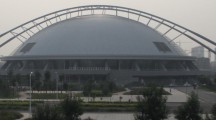Abstract
For studying the dynamic performance of subsea umbilical cable laying system and achieving the goal of cable tension and laying speed control, the rigid finite element method is used to discrete and transform the system into a rigid-flexible coupling multi-body system which consists of rigid elements and spring-damping elements. The mathematical model of subsea umbilical cable laying system kinematic chain is presented with the second order Lagrange equation in the joint coordinate system, and dynamic modeling and simulation is performed with ADAMS. The dynamic analysis is conducted assuming the following three statuses: ideal laying, practical laying under wave disturbance, and practical laying with tension compensation. Results show that motion disturbances of the laying budge under sea waves, especially with heaving and pitching, will cause relatively serious fluctuations in cable tension and laying speed. Tension compensation, i.e., active back tension torque control can restrict continuous tension increasing or decreasing effectively and rapidly, thus avoiding cable breach or buckling.
Similar content being viewed by others
References
Adamiec-Wójcik I, Wojnarowski J (2005). Application of the rigid finite element method to modeling of free vibrations of a band saw frame. Mechanism and Machine Theory, 40(2), 241–285.
Bai Y, Bai Q (2005). Subsea pipelines and risers. Elsevier Science Ltd, Holland, 597–636.
Bi, Gj (2013). Dynamic analysis and experimental study of a subsea flex-lay system. Journal of Harbin Engineering University, 34(6), 753–762.
Dang XB, Gong SF, Jin WL, Zhao DY, He N (2010). Research progress on submarine pipeline laying technology. China Offshore Platform, 25(5), 5–10.
Dieumegar C, Fellows P (2003). Installation of metallic tube umbilicals in 3000 meters water. Offshore Technology Conference, Houston, 5–8 May, Texas, USA.
Guo H, Qu Y, Li B, Wang J (2012). Research situation on domestic and abroad umbilical cord technology and prospect of application in China. China Offshore Oil and Gas, 24(1), 74–78.
Huang WP, Cao J, Zhang EY (2011). State of the art and developing trend of deepwater pipelaying and pipelaying vessel abroad. The Ocean Engineering, 29(1), 135–142.
John W L, Stephen R K (1990). Simulation of tension controlled cable deployment. Applied Ocean Research, 12(1), 34–42.
Peter J S, Simon L (2008). A novel method for coiled tubing installation. Offshore Technology Conference, Houston, Texas, USA.
Płosa J, Wojciech S (2000). Dynamics of systems with changing configuration and with flexible beam-like links. Mechanism and Machine Theory, 35(11), 1515–1534.
Prpić-Oršić J, Nabergoj R (2001). Dynamic tension of marine cables during laying operations in irregular waves. International Shipbuilding Progress, 48(2), 149–167.
Prpić-Oršić J, Nabergoj R (2005). Nonlinear dynamics of an elastic cable during laying operations in rough sea. Applied Ocean Research, 27(6), 255–264.
Sun JJ, Liu PL, Duan ML, Zhang JJ, Hu XW, Gui J (2011). Present situation and tendency of deepwater umbilical cable installation technology. Oil Field Equipment, 40(12), 1–5.
Szczotka M, (2010). Pipe Laying simulation with an active reel drive. Ocean Engineering, 37(7), 539–548.
Szczotka M, Wojciech S (2008). Application of joint coordinates and homogeneous transformations to modeling of vehicle dynamics. Nonlinear Dynamics, 52(4), 377–393.
Wang FS (2010). Study on the flexible multi-body dynamics analysis method of belt conveyor. Ph.D. thesis, China University of Mining and Technology.
Winget JM, Huston RL (1976). Cable dynamics-a finite segment approach. Computers & Structures, 6(6), 475–480.
Wittbrodt E, Adamiec-Wójcik I, Wojciech S (2006). Dynamics of Flexible Multibody Systems: Rigid Finite Element Method. Springer, Berlin, Heidelberg, New York, 83–94.
Yao TQ, Chi YL, Huang YY, Tan Y (2009). Research on multi-body dynamics and contact vibration of belt transmission. Journal of System Simulation, 21(16), 4945–4950.
Zhang H, Li ZG, Zhao HL. Technical state and localization assumption of deep sea pipe laying equipment (2008). China Petroleum Machinery, 36(9), 201–204.
Author information
Authors and Affiliations
Corresponding author
Additional information
Foundation item: Supported by the National Science and Technology Major Project: Development of Large Oil-gas Fields & Coal-bed Methane (No. 2011ZX05056)
Liquan Wang is a professor, Ph.D. supervisor and director of the Underwater Operations Technology and Equipment Laboratory at Harbin Engineering University, China. He obtained PhD in Mechanical Engineering from Harbin Engineering University. He has presided over many scientific research projects and has many papers published in journals. His research interests are underwater equipment design and robot technology.
Rights and permissions
About this article
Cite this article
Bi, G., Zhu, S., Liu, J. et al. Dynamic simulation and tension compensation research on subsea umbilical cable laying system. J. Marine. Sci. Appl. 12, 452–458 (2013). https://doi.org/10.1007/s11804-013-1216-8
Received:
Accepted:
Published:
Issue Date:
DOI: https://doi.org/10.1007/s11804-013-1216-8




